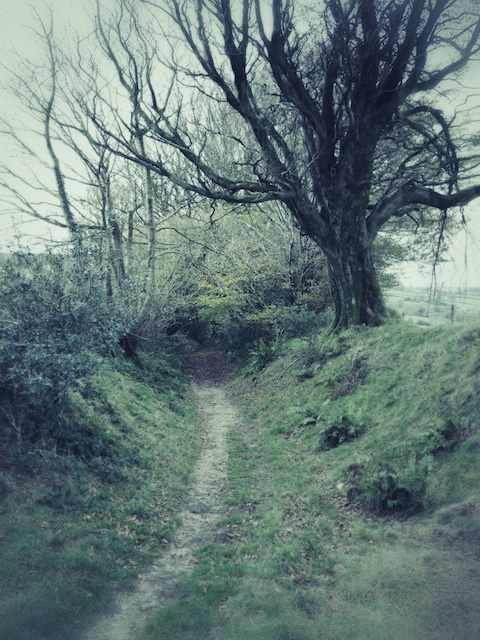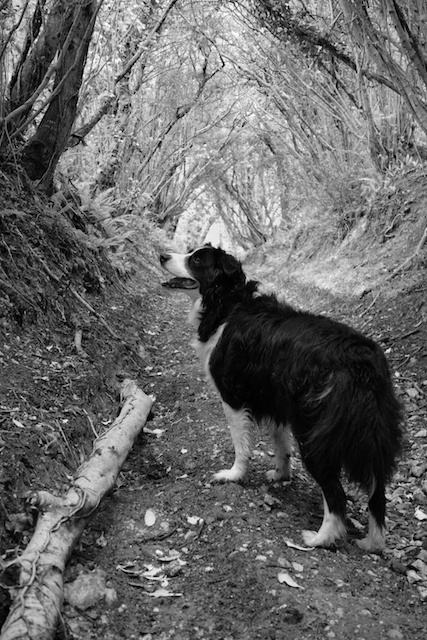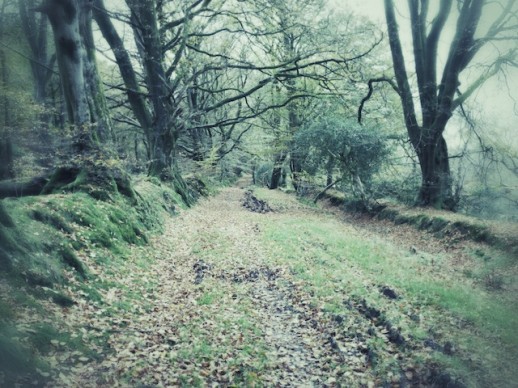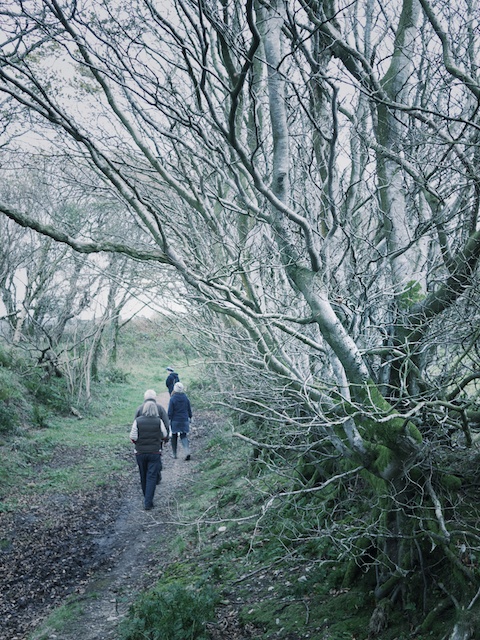
by Malcolm Anderson
It seems of late that the Holloways of West Dorset have been getting a lot of attention. I’ve seen images crafted by marvelously creative artists and photographers and I’ve read the fluid song-like words put down by writers who put my simple descriptive powers to shame. However, one thing has brought me to sit here scribbling in my notebook while a mug of tea steams on the table in front of me, the log stove flickering in the corner. One thing that I just felt I had to try and get off my chest.
You see, the thing is, I’ve spent most of my 41 years in and around West Dorset. I grew up in the Broadwindsor area, attending schools in the shade of historical giants of the landscape. Hill forts, their names so entrenched in our local tradition that our school houses were named after them; Lewesdon, Waddon, Eggardon & Pilsdon. Names that no matter where I live in the world will conjure vivid mental pictures. Memories that will forever smell of gorse flowers, thick moss, beech woods and freedom.

I spent my formative years exploring the un-spoilt beauty of these hill forts with their Beech and Oak clad flanks, running feral through hidden tree and fern choked valleys, splashing in un-named streams. Summers were spent discovering everything from long forgotten roads and roman mosaics through to badger sets that threw up treasures alongside their sandy excavations; flint arrowheads, old bottles with marbles in their necks, shards of pottery. Treasures indeed for young Robinson Crusoe’s and wannabe Famous Five’s.
During the winter of 1978/79 Dorset suffered at the hands of a serious snowfall, driven by bitterly cold easterly winds. According to officials some 46cm of snow fell, but the high winds created drifts of over 9m in places. Broadwindsor, and many other villages like it which nestle in this wooded hilly landscape, connected by small leafy lanes were cut off from the outside world for what seemed to an active seven year old to be an age but in hindsight was probably closer to a week. The holloways heading up past common water lane filled with snow as winds blew across the frost crusted sleeping landscape, packing the loose snow into the high hedged roadways. My parents have an old faded Kodak picture of my brother and I standing on top of a snowdrift up near Conegar Hill like proud shackletons and Feinnes, the arm of a six foot high metal signpost poking lugubriously out of the snow some three feet below us. Homeric parka clad heroes scoping the way to the horizon and far away foreign places such as Littlewindsor and Mosterton. The lanes looked like snowboarding halfpipes, fringed at their summit by leafless fingers, frost crusted and brittle. For those few endless days of winter, we sledged along tunnels of moss, bark and snow until our hands and feet glowed red like the embers in the fire.

Much of West Dorset is best described as a tame wilderness, indelibly shaped by the hand of man yet at the same time was somehow managing to feel truly ancient and wild, the landscape a product of a time when man and nature existed in a more balanced manner than today. Inexplicably the land is by turns brooding and enchanting, stark and lush. The dark and light, the yin and yang of the natural world, scudding on the whim of the changeable weather. I’m now older, although not quite ready to admit to being old and am adventuring through those leafy lanes with my own family but I still get that sense of discovery, that feeling of the unknown being just round the next bend, whenever I’m in those beech woods and streamy, dreamy, moss carpeted valleys.
Although we were a relatively new family to Dorset, my mum & dad having moved down from the North at a time when they were the only ‘foreigners’ within about a ten mile radius of Broadwindsor, by the time I came along the Anderson clan was firmly a part of village life. Outside of school I spent my time playing with friends, accepted into their houses and lives as if we were family members. Mrs Forsey, up on the hill at Blagdon used to see me so often that she kept tins of beans in stock in the larder just in case the skinny Anderson boy was hungry. These were families that had been connected with the West Dorset landscape since before the time that William the Conqueror commissioned the Domesday book in 1085. Families whose ancestors had been known smugglers in the Weymouth area or who had been working the fields and laying hedges for generations. A collective memory existed in these communities, an aural tradition if you will, and it ran thick in the blood of the people of West Dorset up until the last few decades when it has been eroded by the loss of the traditional family names. Families have succumbed to the lure of the town, exacerbated by significant increases in rural house prices and reductions in rural employment. West Dorset has also suffered by becoming, for want of a better word, trendy. As the celebrities have moved in, the traditional names; the Studleys, Phillips, Forseys, Pinneys and Coopers have slowly had to move out.
I’ve gotten slightly diverted there so I should bring this back to my initial reason for writing these words in my own stumbling manner. Not once in my years of being a Dorset boy did I ever hear the term holloway used locally. Not once in my old books, not once while in our cups at the Royal Oak or the White Lion, not once around rough edged farm kitchen tables and oily smelling AGA’s. In fact I didn’t hear the term used until I read Robert Macfarlane’s book ‘The Wild Places’ in 2011 (I know, I came to his writing late). Locally they were just referred to as lanes; Manshay Lane, Sheepwash Lane, Stockham Lane, Lewesdon Hill Lane or just locally as ‘the lane’ or the ‘lane past badger sett copse’.

Holloway. Hollow Way. Holly Way. Holey Way.
Now I’ve heard the word though it does sort of fit, but I’m not sure it conveys the breadth of the hidden historic highways that exist in that part of the world. The holloways of my Dorset range in size and scope from the sublime to the ridiculous. Some are little more than a space between two hedges so small for there to be only room for children to crawl along, brushing shoulders with hedgerow birds nests and tufts of evidence of the passing of wiley sheep escaping the confines of their fields. Undoubtedly in times past they were well used footpaths between clearly defined hedges but falling out of favour they’ve grown in on themseleves to the point of seeming like they are in fact one hedge, only the intrepid or the nosey will know the truth. Other holloways exist that are so large that modern roads pass through them, their historical roots un-noticed by most modern day travellers, their vegetation slowly being killed off by successive years of exhaust pipes emissions.
My favourite holloway I suppose isn’t even really a holloway at all, at least not in the romantic notion that seems to have been written about them lately. Over the years the trees have grown up into ancient specimens, replacing the smaller, denser growth seen in many holloways. The banks have been rummaged around in by foxes and badgers and collapsed and the light has got in. This I suppose must ultimately be the fate of all holloways unless humans intervene and attempt to manage and preserve them as a point in time, but we must beware of the human folly of pretending that we can manage everything and remember that the countryside is forever in a state of flux. Nothing remains forever and change as they say, is inevitable, except from a vending machine.

Ignoring any quibbles about definition of holloways let’s take a walk together. Step off the main road out of Broadwindsor (be careful, there’s almost nowhere to park a car and traffic can speed past) and in the shadow of Pilsdon Pen turn onto the lane heading down to Brimley Coombe Farm. Take an immediate left and you walk into another world. Overhead the beech and hazel trees stand at permanent salute, locking skeletal fingers, creating a tunnel of dappled shade and branches murmuring in an autumn breeze. An arboreal honour guard standing over Lewesdon Hill Lane as it runs up over the edge of Burstock Down, around the base of Lewesdon Hill and on towards Stoke Knapp.
The lane is thought by some to have been part of the Icknield Way, an agger built roman road that ran from Durnovaria (Dorchester) to Isca (Exeter) but there is little evidence of roman origin on the ground between Eggardon Hill and Axminster. Whether the road was indeed Roman or not is a matter for debate and undoubtedly some digging, after all we need to keep Phil from Time Team employed, but regardless of how ancient it’s origins the lane has clearly seen generation upon generation of traffic.
As you walk uphill the witchy fingers of the small trees give way to the more established ancient beeches, sweeping like Justin Bieber’s fringe, shaped by the predominant south westerly winds blowing up off the English Channel. Walk up one bank of this lane and you can see across Dorset and on a clear day make out the Somerset Levels in the distance. Skip down like a 5 year old and back up the other bank and you have an uninterrupted view across a living patchwork of small fields and ancient woody hills across to Golden Cap and the sea.
As you continue on upwards, the lane trickles lazily along the ridges and contours of the Dorset landscape like an earthy stream. Lined by aged Beech trees, gnarled and windswept, curled woody fingers, reaching for jackets and hats as they pass, the lane maintains a shape that on it’s edges hints at the roadway that it must have been. Banks that have obviously seen generations of shovels and picks, and a surface that has been pounded into the Dorset soil by the iron shod and leather booted feet and cartwheels of our ancestors.
Take a detour off the lane and up onto the National Trust owned Lewesdon Hill and once you’ve caught your breath after the steep climb you will be greeted by glimpses through beech and pine of a countryside rolling off into the distance like a patchwork quilt thrown over sleeping children. At the right time of the year the woodland has the most amazing bluebell display and in the autumn you can be kicking your way through fallen leaves well over knee deep. Crunching like freshly fallen snow.
Below you, the Holloway-that-isn’t wends off to Stoke Knapp where you can head up over Waddon and ultimately onto Beaminster or down through another marvelous lane into Stoke Abbott where by now thirsty throats can already feel the welcome of a warm fire and a pint of something refreshing. For those with less fortitude, or fractious children, you can always drop down into Broadwindsor from here.
Note: If you don’t know the area and want to park a car I’d suggest you tackle Lewesdon from the other end, approaching it from the Broadwindsor – Bridport road, parking (safely out of the way of farm traffic) below Crabbs Hill near Bucks Head. You stand a chance of being able to park here.
To read more of Malcolm’s writing on life on and around the river Nadder click here.